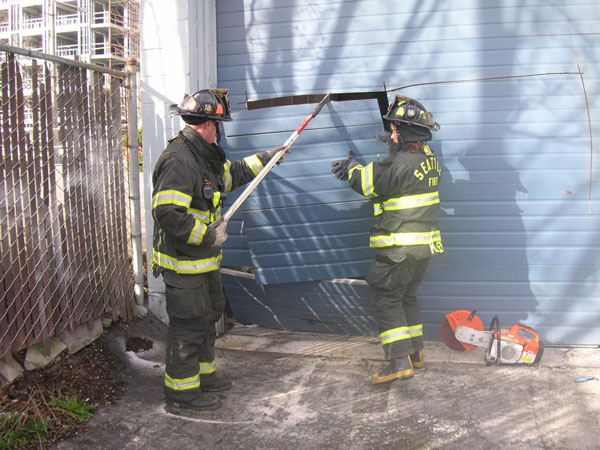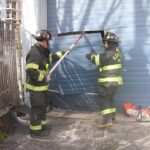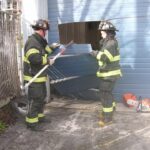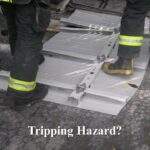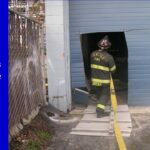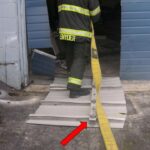
By Raul Angulo
The second drill in this series deals with the forcible entry of roll-up doors. After you cut the door, do you push the panels into the building, or pull them out onto the sidewalk? See the entire drill sequence HERE. But first, here is the company officer administrative tip on training and discipline.
Company Officer Tip
Never use training or drilling as a form a punitive discipline. Discipline can mean good or bad. A military rifle drill team is disciplined in all their twirling executions and they enthusiastically practice to be that disciplined. This is good discipline.
If an engine company blows a chief’s drill by turning a hose stairwell lay into spaghetti fest, they obviously need to practice that evolution. If the company officer runs that drill over and over until they get it right, that is appropriate discipline.
If a company officer drills a firefighter for being late for work or out of uniform, or drills the company for not washing the station windows or doing the yard work–that is bad discipline. You don’t want firefighters to associate training drills with punishment.
When I was transferred to captain of Engine 18, it wasn’t by choice–but that’s another story. I made a nearly fatal error by showing up on my first day in a bad mood. I wanted to let everyone know I wasn’t happy about the transfer. Shortly after breakfast, I took my new crew out to the training tower and drilled them for about two hours on various engine company evolutions.
Now, in my mind this was nothing personal. I didn’t want to specifically drill for two hours, but I knew going over the basics evolutions would take about two hours. I just wanted to get a barometer reading on where my guys were because I had never worked with them before. We were a new crew and I wanted to identify the strengths and weakness of my new company. Though I was having fun (because I love to drill), they were cursing me under their breath. After making it verbally clear that I did not want to be there, they felt I was personally taking my anger out on them. I was, in essence, “kicking the dog.”
If you knew me, you would know that is not my nature. But that’s the point–they didn’t know me, and they concluded that I was a real @#$!&*. If I didn’t want to be there, they didn’t want me at 18’s, either. A peer firefighter (we came in together) who was assigned to the truck brought this to my attention. He was advocating for me, but I still needed to personally do some damage control. I apologized to my crew and the whole station for coming in with a bad attitude. I assured my crew that I wasn’t “kicking the dog.” They accepted my apology, but it took months to rebuild the relationships and establish the trust. I wasted so much time on establishing my leadership influence simply because I came in with a bad attitude.
Later, I was offered my previous captain assignment back but I turned it down and stayed with the guys at Engine 18–a decision I never regretted. I repaired the relationships and built the trust with my crews. We’ve remained very close friends. I learned a valuable lesson in professional growth, but it was a costly one.
Drill: Roll-up Doors–In or Out?
Cutting through the panels of commercial roll-up doors using a rescue saw is a standard forcible entry technique. Good instructors disagree on the best method to cut the door. Some use the traditional teepee cut, some make an entire door. Others use an “X,” an inverted “V,” or a single vertical cut “I” and pull the individual panels out of the track. So which is the best method? That is for you to decide. What’s the objective here? To make entry, right? Is the entry for crews to enter the building? Is the hole for ventilation? Is this ventilation hole going to be used to blow air in, or will it be an exhaust point? Maybe you just want to cut a hole big enough to get a 2 ½-inch nozzle in to flow water. Whatever the reason for cutting a hole in a roll-up door, make sure it is big enough to accomplish the strategy.
The debate about which cut is the best centers around one thing –how many cuts you need to accomplish the task. Apparently, the fewer cuts, the better. Why is there so much concern about limiting the amount of cuts? I personally like to make a huge door. I try to duplicate the opening that would be made if the roll-up door went up on its own. The criticism I get for this preference is, “Yeah, but it takes at least three separate cuts.” And I say, “Yeah, and so what? I have a gargantuan firefighter with a power saw who wants to cut through everything in sight.” The teepee requires three cuts, the “X” or the inverted “V” requires two cuts. There are instructors who boast that the vertical cut (obviously) only requires a single cut. Whoop-de-doo! You still have to use a pair of vice grips to pull the panels out from the tracks and that still takes time. Probably as much time as it takes to make another cut.
Over the course of my career, I’ve cut through many roll-up doors while training on acquired structures, and the rescue saws have gone through these doors like they were butter. I don’t see what the big deal is on making that third cut. Heck! Make four! Just make the hole big enough for the tactical objective. In my 37 years on the job, I have only had to cut a roll-up door on an actual fire once! These double-layered steel panels were so thick, they ate through three saw blades with minimal progress. After using two saws, we finally abandoned efforts and looked for another way into this commercial structure. So there you go.
But here is the question I’ve heard no instructor ever address. If the preference is making two cuts, you’re going to have a flap. Once the door is cut, do you push the door flap into the building? Or do you pull it onto the sidewalk? Pulling the flap out onto the sidewalk is the natural thing to do. You have more strength and control by pulling the door towards you than pushing the flap into the building; however, are you creating more problems for yourself? The next opportunity we had to practice on an acquired structure with a roll-up door, here’s what we found out. And if you notice the helmet shields and the hose stencil, these drills were performed with the members of Engine Company 18!
The exterior door panels are usually smooth. This is for security and building aesthetics. The connectors, hinges, and ridges, etc. are on the interior side of the door. So the first thing we noticed is that pulling the door flap out onto the driveway created multiple tripping hazards for everyone. The next thing we noticed is the saw created very sharp edges along the flap. As the fire hose was being advanced into the building, it was rubbing against and catching on these sharp edges; they could easily cut the fire hose. That wouldn’t be good in a real fire.
Then we pushed the door flap into the building. Not only were the tripping hazards eliminated, the hose advanced smoothly into the building. We concluded that pushing the door flap into the building is the best way to do this. That’s it.
“We will save lives one drill at a time…” — Chief Anthony Kastros
- Q & A: Raul Angulo on Drills You Won’t Find in the Books
- Drills You Won’t Find in the Books: Elevator and Stairwell identification Drill
 RAUL A. ANGULO is a 37-year veteran and captain of Ladder Co. 6 with the Seattle (WA) Fire Department. He is an international author and instructor on various fire service subjects including strategy and tactics with firefighter accountability, crew development, and company officer leadership. He writes the monthly column “Tool Tech” for Fire Apparatus and Emergency Equipment magazine.
RAUL A. ANGULO is a 37-year veteran and captain of Ladder Co. 6 with the Seattle (WA) Fire Department. He is an international author and instructor on various fire service subjects including strategy and tactics with firefighter accountability, crew development, and company officer leadership. He writes the monthly column “Tool Tech” for Fire Apparatus and Emergency Equipment magazine.
